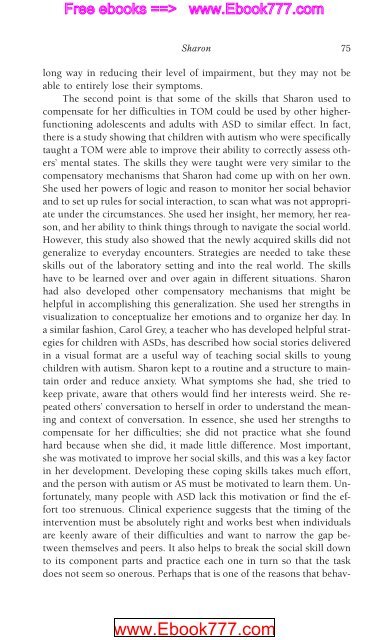978-1572305441
autism
autism
You also want an ePaper? Increase the reach of your titles
YUMPU automatically turns print PDFs into web optimized ePapers that Google loves.
Free ebooks ==> www.Ebook777.com<br />
www.Ebook777.com<br />
Sharon 75<br />
long way in reducing their level of impairment, but they may not be<br />
able to entirely lose their symptoms.<br />
The second point is that some of the skills that Sharon used to<br />
compensate for her difficulties in TOM could be used by other higherfunctioning<br />
adolescents and adults with ASD to similar effect. In fact,<br />
there is a study showing that children with autism who were specifically<br />
taught a TOM were able to improve their ability to correctly assess others’<br />
mental states. The skills they were taught were very similar to the<br />
compensatory mechanisms that Sharon had come up with on her own.<br />
She used her powers of logic and reason to monitor her social behavior<br />
and to set up rules for social interaction, to scan what was not appropriate<br />
under the circumstances. She used her insight, her memory, her reason,<br />
and her ability to think things through to navigate the social world.<br />
However, this study also showed that the newly acquired skills did not<br />
generalize to everyday encounters. Strategies are needed to take these<br />
skills out of the laboratory setting and into the real world. The skills<br />
have to be learned over and over again in different situations. Sharon<br />
had also developed other compensatory mechanisms that might be<br />
helpful in accomplishing this generalization. She used her strengths in<br />
visualization to conceptualize her emotions and to organize her day. In<br />
a similar fashion, Carol Grey, a teacher who has developed helpful strategies<br />
for children with ASDs, has described how social stories delivered<br />
in a visual format are a useful way of teaching social skills to young<br />
children with autism. Sharon kept to a routine and a structure to maintain<br />
order and reduce anxiety. What symptoms she had, she tried to<br />
keep private, aware that others would find her interests weird. She repeated<br />
others’ conversation to herself in order to understand the meaning<br />
and context of conversation. In essence, she used her strengths to<br />
compensate for her difficulties; she did not practice what she found<br />
hard because when she did, it made little difference. Most important,<br />
she was motivated to improve her social skills, and this was a key factor<br />
in her development. Developing these coping skills takes much effort,<br />
and the person with autism or AS must be motivated to learn them. Unfortunately,<br />
many people with ASD lack this motivation or find the effort<br />
too strenuous. Clinical experience suggests that the timing of the<br />
intervention must be absolutely right and works best when individuals<br />
are keenly aware of their difficulties and want to narrow the gap between<br />
themselves and peers. It also helps to break the social skill down<br />
to its component parts and practice each one in turn so that the task<br />
does not seem so onerous. Perhaps that is one of the reasons that behav-



